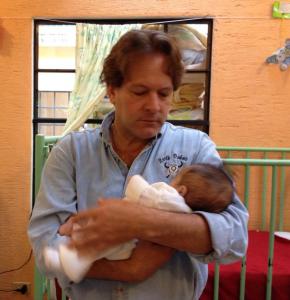Child Crisis along Southern US Border Creates Human Trafficking Nightmare
Unaccompanied children rushing the United State's southern border are creating a human trafficking crisis of unprecedented proportion for the nation.
MINNEAPOLIS, MINNESOTA, UNITED STATES, August 18, 2014 /EINPresswire.com/ -- By Michele De SantisWhen a crisis occurs somewhere in the world, the Bismarck, ND-based international non-profit organization, the ‘Institute for Trafficked, Exploited & Missing Persons’ (www.ITEMP.org) receives hundreds and thousands of calls, emails, and social network messages from people asking for help.
ITEMP was founded in 2001 to bring awareness to the plight of human trafficking victims after its founder, Patrick Atkinson, was held at gunpoint while working in Africa and forced to witness the kidnapping of an entire village. Since then, ITEMP’s success and reputation often puts it at the top of the list of “go to” organizations when things go wrong somewhere in the world. Its staff and volunteers have been at forefront of crises; pulling the living and the dead from the wreckage of hurricanes, earthquakes, tsunamis, car bombings, floods and fires.
With increasing frequency ITEMP is now being asked to provide help to the tens of thousands of Central American children gathered along the United States southern border.
These children are traveling alone, unescorted to ‘el norte’; they are highly vulnerable to being raped, kidnapped, enslaved and trafficked for sexual and labor purposes.
Mr. Atkinson and ITEMP’s staff have worked with mass vulnerabilities like this before; runaways living on the streets of America, refugees from war-zones and the killing fields of Central America and Southeast Asia, and the survivors of the tsunami that swept across Southeast Asia.
“International aid flooded into Southeast Asia after the tsunami,” Atkinson said, “as, unfortunately, did predators looking for lost and orphaned children. They offered a warm bed and a hot meal.”
“What they didn’t mention,” Atkinson says, “is that in exchange for this attention and care, they wanted years of sexual servitude.”
The international headlines covering this game-changing phenomenon act like a guidebook for the men, women and organized crime structures that seek to make money selling children’s innocence.
Mexican and American government authorities report that nearly 100,000 minor children have crossed the southernmost border of the United States in recent weeks. All are traveling illegally and without documentation; to arrive at “el norte”, desperate boys and girls are passing through dangerous cities and zones where there has always been violence, disappearance and rape.
“This is not a migration issue,” Patrick Atkinson says. “It is a human tsunami of unprecedented levels for the United States. Immigration levels have been higher, but never in the history of the country has there been so many children crossing the border alone.”
The causes behind this children’s tsunami are complex, ranging from the high levels of street crime that ravage Central American countries, to semi-authorized government corruption that steals money budgeted to build clinics, schools and other social development projects. “Schools that aren’t built can’t educate children whose only chance to break free from poverty is education,” Atkinson says.
In addition, complications such as family structure, international government reimbursements, political posturing for future elections, vested personal interests, uncertain immigration policies, and mixed-message border-crossing outcomes lay behind what is happening with Latin America children held at the US southern-most border.
“But not one bit matters to a 12-year old sent to meet a relative on the far side of the border who is intercepted, diverted, and harmed for through institutional violence or being kidnapped and sold into years of labor or sexual slavery,” says Atkinson
ITEMP’s response to the humanitarian tragedy along the Mexican – American border is to encourage assist all sides involved to set aside their differences and vested interests and simply “Do the best you can.”
Within the schools, clinics, malnourished infant centers and other ITEMP programs in Central America, efforts are being doubled to keep the children from running to ‘el norte’; to get them off the streets and into school, to keep them safe from violence and fear.
Every day more than 13,700 poor, hungry, injured, and hopeful people walk through a ITEMP door somewhere in the world; whether it’s in Malawi, India, United States, Guatemala, or El Salvador. ITEMP’s anti-human trafficking programs are borderless and reach around the world.
“There are thousands of innocent lives along the southern border of the United States who need protection now,” says Atkinson. “These are children who need help, guidance and protection them from yet another horrible experience that will sentence them to a life of modern day slavery.”
7 7 7
Katherine Solstad
(001) 952-544-1670
email us here
ITEMP - Institute for Trafficked, Exploited and Missing Pers
Legal Disclaimer:
EIN Presswire provides this news content "as is" without warranty of any kind. We do not accept any responsibility or liability for the accuracy, content, images, videos, licenses, completeness, legality, or reliability of the information contained in this article. If you have any complaints or copyright issues related to this article, kindly contact the author above.

